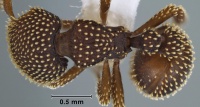Calyptomyrmex danum
| Calyptomyrmex danum | |
|---|---|

| |
| Calyptomyrmex danum | |
| Scientific classification | |
| Kingdom: | Animalia |
| Phylum: | Arthropoda |
| Class: | Insecta |
| Order: | Hymenoptera |
| Family: | Formicidae |
| Subfamily: | Myrmicinae |
| Tribe: | Crematogastrini |
| Genus: | Calyptomyrmex |
| Species: | C. danum |
| Binomial name | |
| Calyptomyrmex danum Shattuck, 2011 | |
This species has been collected several times at a single rainforest site in eastern Sabah.
Identification
Shattuck (2011) - Hairs on head and body spatulate (noticeably narrower near the body and expanded distally and with a rounded tip), gaster smooth to shallowly punctate, propodeum armed with short angular teeth and in dorsal view petiole only slightly broader than long and oval in shape. These characters will separate this species from all other known species except the Australian Calyptomyrmex sparsus. It can be separated from this species in being smaller (head width < 1.12mm vs. head width > 1.12mm), having the head broader than long (CI > 104 vs. CI < 98), with the spatulate hairs on the posterior section of head and mesonotum rising above the underlying body surface (they are closely appressed to the surface in sparsus) and in having the propodeal spines shorter and broader (angle between faces greater than 90°) while they are larger and more strongly angled (angle between faces approximately 90°) in sparsus. Additionally, the sculpturing on the head and body are more weakly developed with the rugae relatively shallow compared to that found in sparsus.
Keys including this Species
Distribution
Latitudinal Distribution Pattern
Latitudinal Range: 4.2024° to 4.2024°.
| North Temperate |
North Subtropical |
Tropical | South Subtropical |
South Temperate |
- Source: AntMaps
Distribution based on Regional Taxon Lists
Indo-Australian Region: Borneo (type locality), Indonesia, Malaysia.
Distribution based on AntMaps
Distribution based on AntWeb specimens
Check data from AntWeb
Countries Occupied
| Number of countries occupied by this species based on AntWiki Regional Taxon Lists. In general, fewer countries occupied indicates a narrower range, while more countries indicates a more widespread species. |

|
Estimated Abundance
| Relative abundance based on number of AntMaps records per species (this species within the purple bar). Fewer records (to the left) indicates a less abundant/encountered species while more records (to the right) indicates more abundant/encountered species. |

|
Biology
Castes
Nomenclature
The following information is derived from Barry Bolton's Online Catalogue of the Ants of the World.
- danum. Calyptomyrmex danum Shattuck, 2011a: 9, figs. 5, 18 (w.q.) BORNEO (East Malaysia: Sabah).
- Type-material: holotype worker, 10 paratype workers, 1 paratype queen.
- Type-locality: holotype Malaysia: Sabah, Danum Valley, 17.xi.1999 (M. Ellwood); paratypes: 2 workers with same data, 1 queen with same data but 19.x.1999, 8 workers with same data but 13.vii.1999.
- Type-depositories: ANIC (holotype); ANIC, BMNH (paratypes).
- Status as species: Akbar & Bharti, 2015: 7 (in key).
- Distribution: Malaysia (Sabah).
Unless otherwise noted the text for the remainder of this section is reported from the publication that includes the original description.
Description
Worker
(n = 4) - CFW 0.17–0.19; CI 106–108: HL 0.95–1.04; HW 1.02–1.10; ML 0.91–1.02; MTL 0.44–0.51; PetI 124–137; PetL 0.24–0.27; PetW 0.30–0.36; PronW 0.62–0.74; SI 51; SL 0.52–0.56.
Mandibles indistinctly striate, more strongly basally, less so apically. Eyes with 6–7 ommatidia in greatest diameter. Propodeum in lateral view with short, broadly angular teeth. Propodeal lobes uniform in thickness. Node of petiole in profile slightly higher than and approximately the same thickness as the post- petiole. In dorsal view the petiolar node narrower than postpetiolar node. Head, promesonotum and petiolar and postpetiolar nodes irregularly rugose, the rugae enclosing foveolate spaces, the rugae less well developed on the postpetiole. Sides of mesosoma irregularly rugose, more strongly on pronotum, weakly so on propodeum. Spaces between rugulae indistinctly shagreened or finely reticulate-punctulate, matt and dull. Gaster finely and indistinctly sculptured, moderately shiny. Hairs on head and body spatulate and appressed. Clypeal fork hairs thickened, the medial hairs thinner and less spatulate than the lateral hairs. Colour dull red-brown.
Type Material
Holotype worker and 10 worker and 1 queen paratype from Danum Valley, Sabah, Malaysia, M. Ellwood (holotype and 2 worker paratypes collected 17 November 1999, queen collected 19 October 1999 (The Natural History Museum), 8 worker paratypes collected 13 July 1999 (Australian National Insect Collection, The Natural History Museum)).
References
References based on Global Ant Biodiversity Informatics
- Shattuck S. O. 2011. Revision of the ant genus Calyptomyrmex (Hymenoptera: Formicidae) in South-east Asia and Oceania. Zootaxa 2743:1-26.

